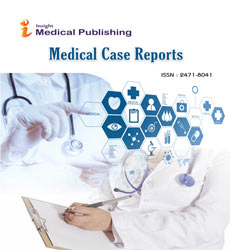The Overlooked Link Between Chronic Midgut Volvulus and Protein-Losing Enteropathy
Hamper Tinner
Department of Pediatrics, Duke University, Durham, United States of America
Published Date: 2024-11-25DOI10.36648/2471-8041.10.6.407
Hamper Tinner*
1Department of Pediatrics, Duke University, Durham, United States of America
- *Corresponding Author:
- Hamper Tinner
Department of Pediatrics, Duke University, Durham, United States of America
E-mail: hamper@gmail.com
Received date: October 25, 2024, Manuscript No. IPMCRS-24-20062; Editor assigned date: October 28, 2024, PreQC No. IPMCRS-24-20062 (PQ); Reviewed date: November 11, 2024, QC No. IPMCRS-24-20062; Revised date: November 18, 2024, Manuscript No. IPMCRS-24-20062 (R); Published date: November 25, 2024, DOI: 10.36648/2471-8041.10.6.407
Citation: Tinner H (2024) The Overlooked Link Between Chronic Midgut Volvulus and Protein-Losing Enteropathy. Med Case Rep Vol.10 No.6: 407.
Description
In the field of pediatric gastrointestinal disorders, some conditions are frequently ignored, misdiagnosed or linked to more prevalent issues. A particularly overlooked connection is between chronic midgut volvulus and Protein-Losing Enteropathy (PLE), a condition that may arise from Intestinal Lymphangiectasia (IL). The unusual nature of this correlation complicates diagnosis, yet a recent case demonstrates the critical importance of this diagnosis for both healthcare providers and families. A 2-year-old child exhibiting symptoms of malabsorption, edema and failure to thrive was diagnosed with chronic midgut volvulus resulting in secondary IL and ongoing PLE. The child’s recovery following surgical treatment highlights the vital significance of prompt diagnosis and intervention in these intricate cases [1].
A hidden cause of PLE
PLE is a condition characterized by excessive protein loss through the gastrointestinal tract, leading to various nutritional deficiencies, edema and stunted growth. While multiple causes contribute to PLE, including inflammatory bowel disease and infections, one of the rarer and less recognized causes is IL. IL occurs when the lymphatic vessels within the intestines become unusually dilated and permeable, allowing proteins, fats and lymphocytes to leak into the gut, rather than being correctly absorbed or circulated in the body [2].
Frequently, IL is associated with primary lymphatic malformations or secondary factors such as infections, tumors or connective tissue disorders. However, in this case, it was chronic midgut volvulusthe twisting of the intestines that resulted in secondary IL and the ensuing PLE. The occurrence of chronic volvulus in this pediatric patient highlights a significant link between gastrointestinal obstruction and lymphatic disruption, two elements that are often managed independently [3].
Chronic volvulus can manifest with vague, mild symptoms such as bloating, intermittent vomiting and poor weight gain, often going undetected for extended periods. Unlike acute volvulus, which presents suddenly with severe pain and obstructive symptoms, chronic volvulus can develop gradually over time. It leads to alternating twisting and untwisting of the intestines, potentially resulting in blood supply interruption, lymphatic stasis and ultimately, IL and PLE [4]. This case serves as a crucial reminder that even in the absence of typical indicators of intestinal obstruction, chronic volvulus should be considered in the differential diagnosis when a patient present with unexplained gastrointestinal issues [5].
The role of timely surgery
The importance of surgical intervention in addressing chronic volvulus and correcting mal rotation cannot be underestimated. In this instance, following the confirmation of diagnosis, the child successfully underwent detorsion and Ladd’s procedure, alleviating the volvulus and restoring normal intestinal function. Subsequently, the patient exhibited significant improvement, with a notable reduction in gastrointestinal symptoms, including foul-smelling stools, bloating and edema. The surgery, though invasive, targeted the root cause of the issue and facilitated normal growth and development post-operation [6].
This case also emphasizes the significance of employing imaging tools such as CT, MRI and upper GI series in the diagnostic procedure. For patients with unclear or recurring symptoms, these imaging examinations can uncover underlying problems such as mal rotation or volvulus, which, if neglected, may result in serious complications like IL, PLE and even bowel necrosis [7].
The need for vigilance and awareness
The infrequency of chronic volvulus as a reason for IL and PLE highlights the necessity for increased awareness in identifying the condition. Pediatricians and gastroenterologists must recognize this potential, especially when patients exhibit poor weight gain, malabsorption and laboratory results indicating protein-losing enteropathy. Early identification and surgical action are important in preventing long-term complications, including lasting nutritional deficiencies, growth delays and even organ dysfunction [8].
Furthermore, this case emphasizes the need for a comprehensive diagnostic strategy that involves evaluating both the gastrointestinal and lymphatic systems [9]. While PLE is generally considered a result of inflammatory or infectious factors, acknowledging the possible association between volvulus, IL and PLE is a step towards more precise diagnoses. Given the severe effects of PLE on a child’s overall health, this case serves as a prompt for healthcare professionals to explore less common, yet potentially treatable, sources of malabsorption [10].
Conclusion
This uncommon yet midgut case reinforces the importance of considering chronic midgut volvulus as a possible cause of protein-losing enteropathy and lymphatic obstruction in pediatric patients. It demonstrates how an often-ignored condition can present with nonspecific symptoms and highlights the necessity of prompt imaging and surgical correction. By acknowledging this connection, clinicians can better assist their patients, ensuring that children experiencing recurrent gastrointestinal symptoms receive the most suitable and effective care. The patient’s remarkable recovery after surgery serves as a strong reminder that accurate diagnosis, when paired with timely intervention, can greatly enhance a patient’s quality of life and outlook.
References
- Mogairen S M Al (2011) Lupus protein-losing enteropathy (LUPLE): A systematic review. Rheumatol Int 31: 995-1001
[Cross Ref] [Google Scholar] [Index]
- Chen W L, Tsao Y T (2009) Protein-losing enteropathy with mesenteric venous thrombosis: a forme fruste of systemic lupus erythematosus. Lupus 18:1331-1333
[Cross Ref] [Google Scholar] [Index]
- Mirrakhimov A E, Ali A M, Barbaryan A, Prueksaritanond S, Hussain N (2014) Primary nephrotic syndrome in adults as a risk factor for pulmonary embolism: An up-to-date review of the literature. Int J. Nephrol 2014: 916760
[Cross Ref] [Google Scholar] [Index]
- Lionaki S, Derebail K V, Hogan S L, Barbour S, Lee T et al. (2012) Venous thromboembolism in patients with membranous nephropathy. Clin J Am Soc Nephrol 7: 43-51
[Cross Ref] [Google Scholar] [Index]
- Kurolap A, Eshach-Adiv O, Hershkovitz T, Paperna T, Mory A et al. Loss of CD55 in eculizumab-responsive protein-losing enteropathy N Engl J Med 377: 87-89
[Cross Ref] [Google Scholar] [Index]
- Zellos A, Zarganis D, Ypsiladis S, Chatzis D, Papaioannou G et al. Malrotation of the intestine and chronic volvulus as a cause of protein-losing enteropathy in infancy. Pediatrics 129: e515-518.
[Cross Ref] [Google Scholar] [Index]
- Nagdeve N G, Qureshi A M, Bhingare P D, Shinde S K (2012) Malrotation beyond infancy. J Pediatr Surg 47:2026-2032.
[Cross Ref] [Google Scholar] [Index]
- Andrassy R J, Mahour G H (1981) Malrotation of the midgut in infants and children: A 25-year review. Arch Surg 116:158-160.
[Cross Ref] [Google Scholar] [Index]
- Kapfer S A, Rappold J F (2004) Intestinal malrotation-not just the pediatric surgeon's problem. J Am Coll Surg 199:628-635.
[Cross Ref] [Google Scholar] [Index]
- Imamoglu M, Cay A, Sarihan H, Sen Y Rare clinical presentation mode of intestinal malrotation after neonatal period: Malabsorption-like symptoms due to chronic midgut volvulus. Pediatr Int 46:167-170.
[Cross Ref] [Google Scholar] [Index]

Open Access Journals
- Aquaculture & Veterinary Science
- Chemistry & Chemical Sciences
- Clinical Sciences
- Engineering
- General Science
- Genetics & Molecular Biology
- Health Care & Nursing
- Immunology & Microbiology
- Materials Science
- Mathematics & Physics
- Medical Sciences
- Neurology & Psychiatry
- Oncology & Cancer Science
- Pharmaceutical Sciences
